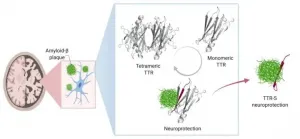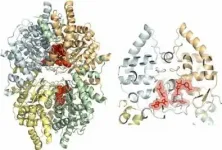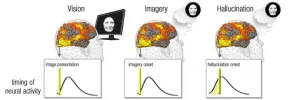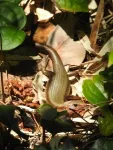What happens when your brain can't tell which way is up or down?
Study shows that how we perceive our orientation affects our perception of self-motion
2021-01-07
(Press-News.org) TORONTO, January 7, 2021- What feels like up may actually be some other direction depending on how our brains process our orientation, according to psychology researchers at York University's Faculty of Health.
In a new study published in PLoS One, researchers at York University's Centre for Vision Research found that an individual's interpretation of the direction of gravity can be altered by how their brain responds to visual information. Laurence Harris, a professor in the Department of Psychology in the Faculty of Health and Meaghan McManus, a graduate student in his lab, found, using virtual reality, that people differ in how much they are influenced by their visual environment.
Harris and McManus say that this difference can help us better understand how individuals use visual information to interpret their environment and how they respond when performing other tasks.
"These findings may also help us to better understand and predict why astronauts may misestimate how far they have moved in a given situation, especially in the microgravity of space," says Harris.
In this virtual-reality-based study, McManus and Harris had their participants lie down in a virtual environment that was tilted so that the visual "up" was above their head and not aligned with gravity. They found that the participants could be divided into two groups: one group who perceived they were standing up vertically (aligned with the visual scene) even though they were actually lying down, and a second group who maintained a more realistic idea of their lying position.
The researchers called the first group, "Visual Reorientation Illusion vulnerable" (VRI-vulnerable). The two groups of participants, while in the same physical orientation and seeing the same scene, experienced simulated self-motion through the environment differently. Those that were VRI-vulnerable reported feeling that they were moving faster and further than those that were not. "Not only did the VRI-vulnerable group rely more on vision to tell them how they were oriented, but they also found visual motion to be more powerful in evoking the sensation of moving through the scene," added Harris.
"On Earth, the brain has to constantly decide whether a given acceleration is due to a person's movements or to gravity. This decision is helped by the fact that we normally move at right angles to gravity. But if a person's perception of gravity is altered by the visual environment or by removing gravity, this distinction becomes much harder."
"The findings reported in this paper could be helpful when we land people on the Moon again, on Mars, or on comets or asteroids, as low-gravity environments might lead some people to interpret their self-motion differently - with potentially catastrophic results," says Harris. The findings could also be helpful for virtual reality game designers, as certain virtual environments may lead to differences in how players interpret and move through the game. Researchers say that the findings may also inform models of how aging may affect the ability to move around and to balance.
INFORMATION:
York University is a modern, multi-campus, urban university located in Toronto, Ontario. Backed by a diverse group of students, faculty, staff, alumni and partners, we bring a uniquely global perspective to help solve societal challenges, drive positive change and prepare our students for success. York's fully bilingual Glendon Campus is home to Southern Ontario's Centre of Excellence for French Language and Bilingual Postsecondary Education. York's campuses in Costa Rica and India offer students exceptional transnational learning opportunities and innovative programs. Together, we can make things right for our communities, our planet, and our future.
Media contact:
Anjum Nayyar, York University Media Relations, cell 437-242-1547, anayyar@yorku.ca
ELSE PRESS RELEASES FROM THIS DATE:
2021-01-07
DALLAS - Jan. 7, 2020 - A protein that wreaks havoc in the nerves and heart when it clumps together can prevent the formation of toxic protein clumps associated with Alzheimer's disease, a new study led by a UT Southwestern researcher shows. The findings, published recently in the Journal of Biological Chemistry, could lead to new treatments for this brain-ravaging condition, which currently has no truly effective therapies and no cure.
Researchers have long known that sticky plaques of a protein known as amyloid beta are a hallmark of Alzheimer's and are toxic to brain cells. As early as the mid-1990s, other proteins were discovered in these plaques as well.
One of these, a protein known as transthyretin (TTR), ...
2021-01-07
Brazilian researchers have managed to decipher the structure of a protein found in parasites that cause neglected tropical diseases, paving the way to the development of novel medications. Thanks to the discovery it will be possible to seek more potent molecules capable of destroying the pathogens directly, with fewer adverse side-effects for patients.
The study detailed the structural characteristics of the protein deoxyhypusine synthase (DHS), found in Brugia malayi, one of the mosquito-borne parasites that cause elephantiasis, and in Leishmania major, the protozoan that causes cutaneous leishmaniasis.
Elephantiasis, also known as lymphatic filariasis, is an infection of the lymph system that can lead to swelling of the legs, arms, and genitalia. It may also harden and ...
2021-01-07
HOUSTON - (Jan. 7, 2021) - Proteogenomic analysis may offer new insight into matching cancer patients with an effective therapy for their particular cancer. A new study identifies three molecular subtypes in head and neck squamous cell carcinoma (HNSCC) that could be used to better determine appropriate treatment. The research led by Baylor College of Medicine, Johns Hopkins University and the National Cancer Institute's Clinical Proteomic Tumor Analysis Consortium (CPTAC) is published in the journal Cancer Cell.
Researchers profiled proteins, phosphosites and signaling ...
2021-01-07
TROY, N.Y. -- In a money-saving revelation for organizations inclined to invest in specialized information technology to support the process of idea generation, new research suggests that even non-specialized, everyday organizational IT can encourage employees' creativity.
Recently published in the journal Information and Organization, these findings from Dorit Nevo, an associate professor in the Lally School of Management at Rensselaer Polytechnic Institute, show standard IT can be used for innovation. Furthermore, this is much more likely to happen when the technology is in the hands of employees who are motivated to master technology, understand their role in the organization, ...
2021-01-07
In a study to examine a Mediterranean diet in relation to prostate cancer progression in men on active surveillance, researchers from The University of Texas MD Anderson Cancer Center found that men with localized prostate cancer who reported a baseline dietary pattern that more closely follows the key principles of a Mediterranean-style diet fared better over the course of their disease.
"Men with prostate cancer are motivated to find a way to impact the advancement of their disease and improve their quality of life," said Justin Gregg, M.D., assistant professor of Urology and lead author of the study, published today in Cancer. ...
2021-01-07
Tsukuba, Japan - Does losing weight while you sleep sound too good to be true? According to a study by the University of Tsukuba, it seems that drinking oolong tea might help you do just that.
While all tea comes from the same plant, Camellia sinensis, the degree of oxidation, a chemical reaction that turns tea leaves black, defines its specific type. For example, green tea is unoxidized and mild in flavor, while the distinctive color of black tea comes from complete oxidation. Oolong tea, being only partially oxidized, lies somewhere in between and displays characteristics ...
2021-01-07
Some people have lost their eyesight, but they continue to "see." This phenomenon, a kind of vivid visual hallucination, is named after the Swiss doctor, Charles Bonnet, who described in 1769 how his completely blind grandfather experienced vivid, detailed visions of people, animals and objects. Charles Bonnet syndrome, which appears in those who have lost their eyesight, was investigated in a study led by scientists at the Weizmann Institute of Science. The findings, published today in Brain, suggest a mechanism by which normal, spontaneous activity in the visual centers of the brain can trigger visual hallucinations in the blind.
Prof. Rafi Malach and his group members of the Institute's Neurobiology Department research the phenomenon of spontaneous "resting-state" ...
2021-01-07
Research from life-saving charity Air Ambulance Kent Surrey Sussex (KSS) in partnership with the University of Surrey has shown the benefits of dispatching HEMS to patients with a sudden, unexplained LOC of medical origin and a high prevalence of acute neurological pathology.
The study - which is believed to be the first published about HEMS dispatch to non-trauma (neuro) cases - also highlights how HEMS dispatchers in dialogue with ambulance personnel are able to select patients requiring HEMS-specific interventions and, based on its findings, identifies opportunities to improve triage for these patients.
Through a retrospective study of all patients with a LOC ...
2021-01-07
In a study spanning four decades, researchers from the University of Hong Kong's Research Division for Ecology & Biodiversity (HKU) in the Faculty of Science, and Toho University's Department of Biology (Toho), Japan, have discovered that predation by snakes is pushing lizards to be active at warmer body temperatures on islands where snakes are present, in comparison to islands free from snakes. Their work also detected significant climatic warming throughout the years and found lizard body temperatures to have also increased accordingly. The findings show that lizard thermal biology is highly dependent on predation pressures ...
2021-01-07
Geneva, Switzerland, 7 January 2021 - 'Mini-brains' are pin-head sized collections of several different types of human brain cell. They are used as a tool, allowing scientists to learn about how the brain develops, study disease and test new medicines. Personalized 'mini-brains' can be grown from stem cells generated from a sample of human hair or skin and could shed light on how brain disease progresses in an individual and how this person may respond to drugs.
Research published today by a team of scientists and engineers from HEPIA and the Wyss Center for Bio and Neuroengineering, in the journal Frontiers in Bioengineering and Biotechnology, has revealed ...
LAST 30 PRESS RELEASES:
[Press-News.org] What happens when your brain can't tell which way is up or down?
Study shows that how we perceive our orientation affects our perception of self-motion



